New Tensions and Permissiveness Render Old Tropes Fresh and Volatile
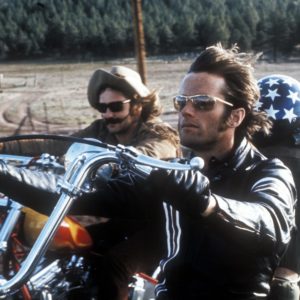
“Did you ever dream about a place you never really recall being to before? A place that maybe only exists in your imagination? Some place far away, half remembered when you wake up. When you were there, though, you knew the language. You knew your way around. *That* was the sixties”.
[pause…]
“No. It wasn’t that either. It was just ’66 and early ’67. That’s all there was.”
– Terry Valentine (as played by Peter Fonda) in The Limey (1999, dir. Steven Soderbergh)

ZekeFilm is 10 years old in 2022! We’re commemorating it with a year-long Film Admissions series wherein each month, we take on a decade (give or take) of cinema, in chronological order. As is always the case with Film Admissions, participants are encouraged to watch a film within that month’s topic that they’ve never seen but have been meaning to. The bigger and more well known the film, the better! Then, together, we share our individual thoughts on our findings.
Lawrence of Arabia
Directed by David Lean/1962
by Taylor Blake
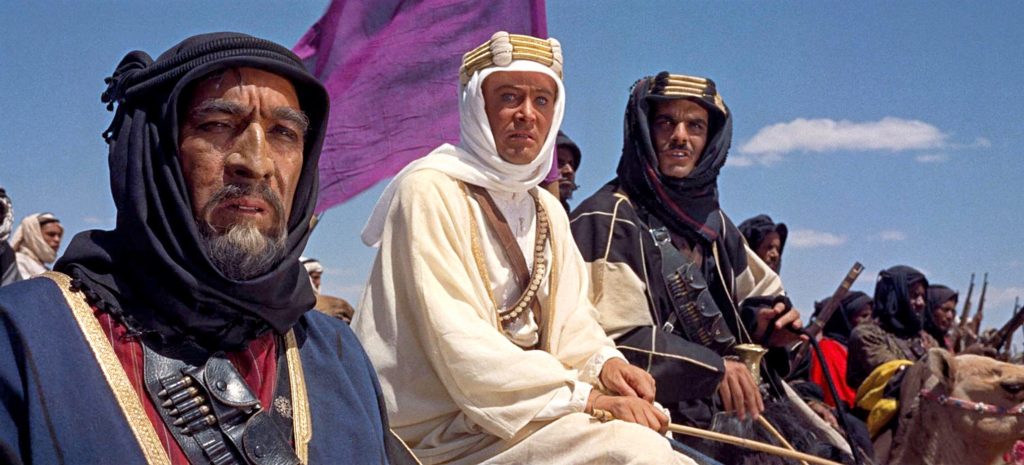
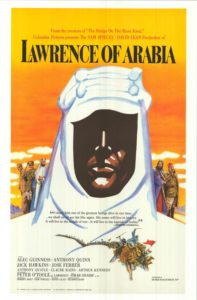
“Whoooo are youuuu?”
The phrase rings across the desert when T.E. Lawrence (Peter O’Toole) and his squad arrive at one of their many stop in the desert, but it also rings inside of him.
Plenty of audience members in 1962 lived or fought through World War I and understood the context of the Arabian fight for independence from the Ottoman Empire—thank goodness that knowledge isn’t necessary. My comprehension of military strategy is, um, shaky (at best), but even when I was skimming Wikipedia to keep track of Lawrence’s British campaigns, I could still cling to his identity crisis in this complex epic.
A few details may date this Best Picture winner (ahem, no matter how talented Sir Alec Guinness is, I doubt he’s the best choice to play an Arabian prince), but what makes this story universal is watching someone struggle with their purpose. Lawrence waffles between commitment to his ideals and the practicality of conformity so many times it’s just as difficult for the audience to decide where he belongs as it is for him. He comes alive when fighting with Sherif Ali (Omar Sharif), but he also gives into his most violent impulses. He saves the British’s campaign in the Middle East, but he can’t stomach the two-faced politics inseparable from his promotions. And he is no “white savior”—David Lean’s film is just as critical of his god complex as it is dedicated to showing off his accomplishments.
Lawrence of Arabia is as breezy as its desert setting—which is to say I needed two sittings to absorb the 3 1⁄2 hours—but it’s also as beautiful and overwhelming. Nothing says “spectacle” like hundreds of camels racing across Wadi Rum, and every detail of the set, costumes, cinematography, and score matches that level of grandeur. O’Toole’s performance plays subtler but just as authentic—if he’d lost the Oscar to anyone but Gregory Peck in To Kill a Mockingbird, it would’ve been an upset.
Cool Hand Luke
Directed by Stuart Rosenberg/1967
by Jim Tudor
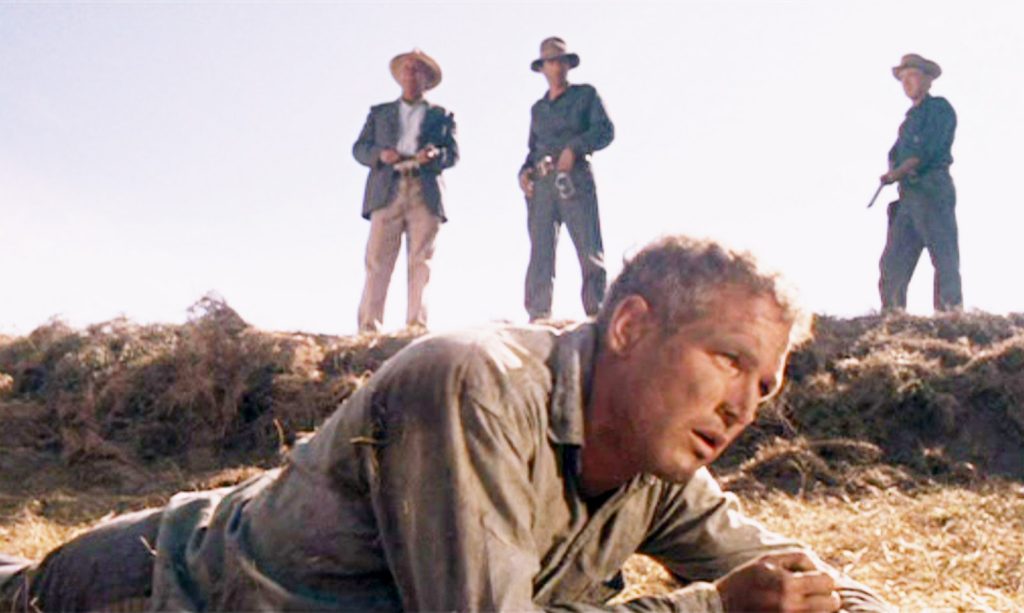
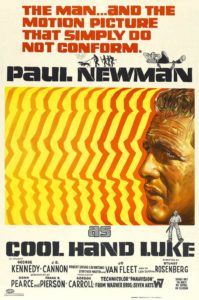
In my many years of participating in various “Film Admissions”-style pieces, Cool Hand Luke has been at the top of my list. When I finally bought the Blu-ray in ‘09, it seemed as though I’d finally be getting around to marking this seemingly seminal classic off my Movie List of Shame. Then thirteen more years went by. Hey, it happens! The passage of time being what it is, it’s true that Cool Hand Luke, along with whatever astonishment that I’d never seen it, faded. But in my mind, it remained perhaps my most glaring Film Omission. What’s crazy, but also completely in character, is that I darn near passed on it this time as well. “What if we do ‘Film Admissions: Paul Newman’ some day?”, I thought- as though I’ve also seen every other movie that Paul Newman ever made, which isn’t remotely true. No, it was finally time to break free of the bondage of my Cool Hand Luke ignorance.
For anyone who hasn’t seen the film (a growing number, I’m sure), Cool Hand Luke is the story of a quiet military hero who gets busted one night while sawing the heads off of parking meters. He ends incarcerated, working outdoor hard labor in the Deep South. There’s an almost mystical contentedness to Luke, who remains at all times an enigmatic man of few words. Then one day, he up and decides to make a break for it. Though unsuccessful, his bold effort (soon to be “efforts”) inspires his fellow inmates. One of them, the imposingly boisterous and emotionally raw presence known as “Dragline” (George Kennedy in what may we be his finest role, the plum opposite of Luke) takes Luke (Paul Newman, of very few words and his blue eyes at their most piercing) under his wing. He champions Luke through the famous impromptu prison barracks bet that Luke can eat fifty hard-boiled eggs in an hour. High stakes eating has never been more gripping nor more arbitrary.
“If this were released today, it’d be an art house movie”. It’s a almost a cliché to point to an older popular film and say that, but for Cool Hand Luke, they may’ve coined the observation decades ago. As directed by Stuart Rosenberg (The Amityville Horror; The Pope of Greenwich Village) and based on Donn Pearce’s 1965 novel of the same title, this Paul Newman vehicle is particularly contemplative, mysterious, weirdly religious, and above all, existential. Yet it’s also tactile, humanist, aching on its surface, but perpetually watchable; an unavoidable product of late-‘60s social angsts both longstanding and emerging. Not only does “The Boss” loom large with his intimidating silver shades and rifle at the ready, there’s signs, signs, everywhere. “Do this”, “don’t do that”…. The tale comes down to a simple man forsaken by his country that’s fully embracing a doctrine of the cruel and unusual. Luke’s heroic past is immaterial. But the ability to eat fifty eggs in an hour makes him a bigger hero… for only a minute. For a film most remembered now for its characters professed “failure to communicate”, Cool Hand Luke continues to communicate an awful lot.
Midnight Cowboy
Directed by John Schlesinger/1969
by Robert Hornak
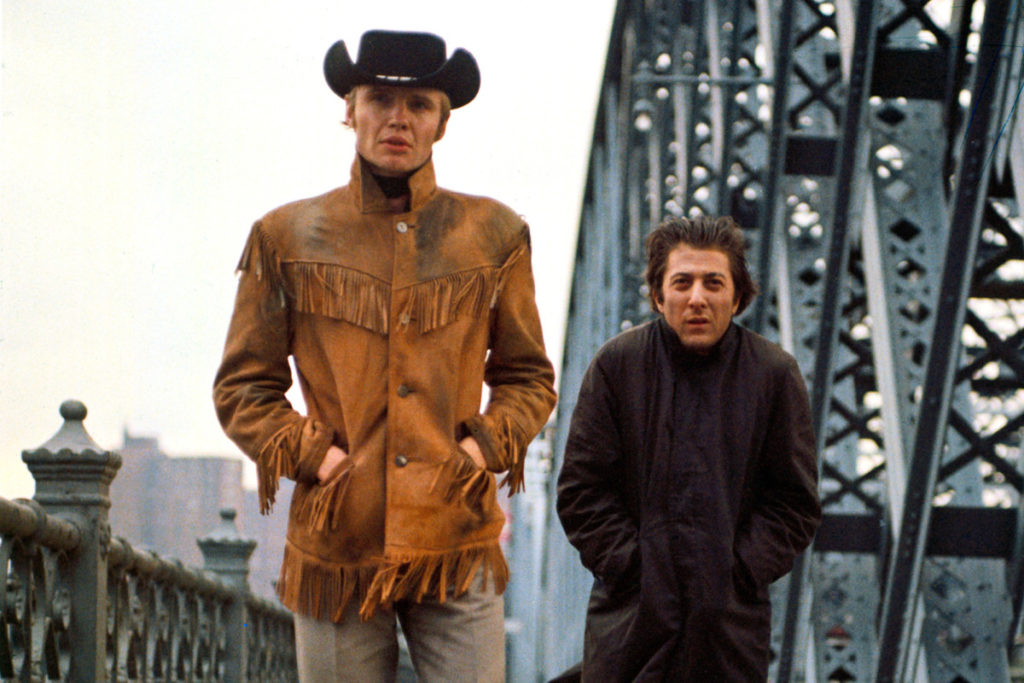
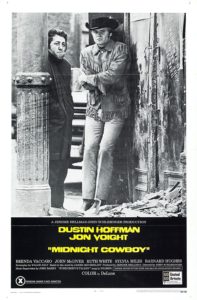
The more I watched this movie the more I thought there’s no way every one of its many rich details hasn’t been written about ad nauseam for five solid decades – meaning, everything I say here is bound to sound like the spatterings of a toddler who’s just realized how awesome Mr. Rogers is. Nevertheless, here are my impressions having seen it for the first time ever. When the first image is a little boy playing cowboy in a derelict drive-in movie lot, you know you’re about to get a treatise on “what’s next” for movies, along with a kind of elegy on what came before it. Only moments later, when Joe Buck is trekking back to work for his final paycheck, and he passes a movie marquee with tattered signage for an old John Wayne movie, the deal is sealed on the passing of what was. By then you don’t even need the image of Buck standing amongst the other hustlers, all in their own variations of cowboy get-up, to understand that this movie wants you to hurt by the passing of something stalwart and independent into the realm of cultural flotsam and kitsch. And by then you can see it in Buck’s eyes that he knows his Texas-born grip on self has slipped away forever and that he’s lost.
Once the movie’s opened itself up to that kind of symbolic interpretation – from its first moments no less – then nothing is safe from the Film School 101 take on everything. Like what does it mean that two of the pivotal sex scenes in the movie show closeups of Buck’s back rolling over onto inanimate objects in the bed with him – one a remote control that begins changing channels on a nearby TV to create what is essentially a quick montage of crass, bloated consumption offered by American capitalism, a montage that ends on a slot machine orgasmically discharging its silver prize; the other a scattered collection of Scribbage dice, the random letters meant to be cobbled into ad hoc communication… in this case, a game played to distract Buck from his pesky impotence, until the dice have worked and then they are needed no more. The intent of all this seems attached to the irresistible lure/destructive force of commerce and the ephemeral nature of communication, but all this groping for hard meaning feels like a cruel tease when you get to the hazily visceral salad-shooter of imagery that is the club scene toward the end – Buck’s been invited to a raucous shindig where the movie’s X-rating can be found peeking and poking inside a collage of nudity, sex, and drugs in a free-for-all of gauzy lighting and jarring edits. It’s the direct descendent of Don Siegel’s Coogan’s Bluff club scene the previous year, while both behave like the undisciplined children of Peckinpah’s wild wedding sequence in Ride the High Country half a decade prior. But here it doesn’t feel so much like Peckinpah’s wanton envelope pushing or Siegel’s quasi-condescension (from Coogan’s squinty perspective), but more a matter-of-fact document of big city life that we know our hero simply doesn’t belong near. There’s our Joe Buck, in Gump-like suspension between wide-eyed acceptance and soul-sucking history in the making.
The beauty of the movie is it’s being so nearly overstuffed with would-be thematic details like this and yet feeling completely singular in its character-driven push toward that iconic ending. I’ve seen that piece of the movie many times – and even more times spoofed – but never knew the litany of meanness and demoralization that led to it, so never knew its powerful weight. Joe Buck, hoping for something larger than his tiny hometown to fill the space left by the death of his grandmother, packs up his true-blue innocence and heads for the big city – we’re never told just what his ultimate goal is – and is systematically instructed on the rules of Real Life by a series of marauders and tricksters, namely Dustin Hoffman’s impeccable creation, Ratso Rizzo, who first hustles Buck out of 50 clams, but ends up on the receiving end of Buck’s goodness enough times that he actually smacks of redemption by the end. Buck carries his goodness into hell and comes up loyal, holding onto his charge through his hobbling sickness and even past death. The moment Buck literally throws away his costume – that which he most wanted to be, or at least most thought he was supposed to be – might be a bit on the nose in terms of character arc, but is still a gut punch of relief: you spend the whole movie wanting to hug the wayward Buck, but the end has him doing the hugging, around the dead body of the only one who every showed anything authentic toward him. I didn’t expect it at all, but this is a pastiche of satire, melodrama, brotherhood, earnest disappointment, and nearly Christian-movie levels of sinner-saved-by-grace. It’s an unexpectedly heady, arty confection that makes sense in the winner’s circle for that time, and continues to make a case for itself as relevant far beyond the late-‘60s cultural tide-turning that it embodies.
The Subject was Roses
Directed by Ulu Grosbard/1968
by Justin Mory
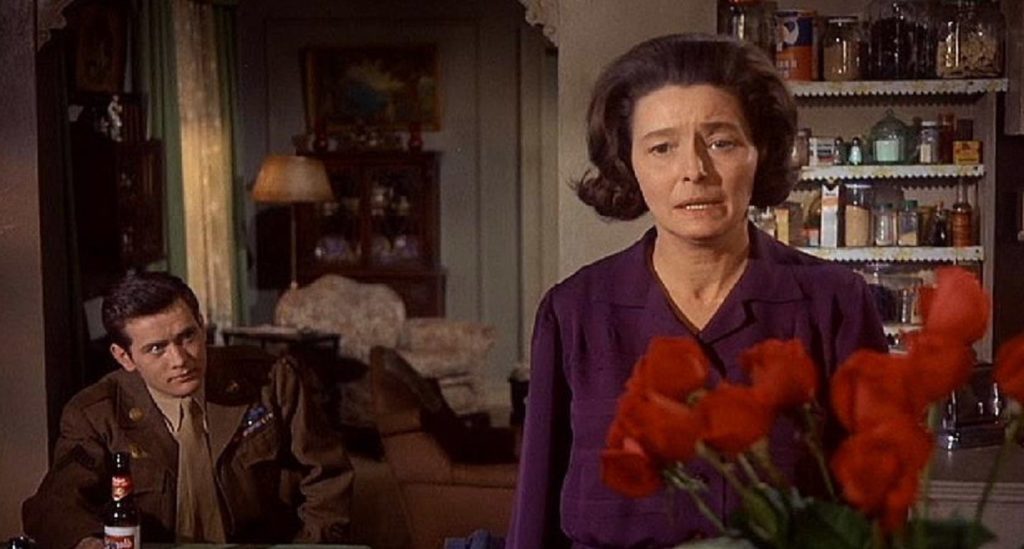
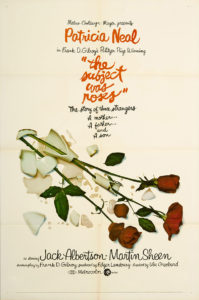
Frank G. Gilroy’s Pulitzer Prize-winning 1964 play concerns the solidly middle-class, Irish-Catholic Clearly family of the Bronx, New York City. On the weekend of son Tommy’s return from World War II, the homecoming begins brightly enough, set in the Cleary’s comfortable if somewhat worn-out four-room apartment, but soon the resentments and recriminations of the past two decades reassert themselves with the weathered inevitability of old wounds. The emotional battle zone between distant father John and withdrawn mother Nettie – with peacekeeping son Timmy caught in the middle – spends itself out with something approaching resolution if not, in the end, total forgiveness. Timmy cutting his visit short early Monday morning, moving out if not, again, entirely on, we realize that the son probably won’t be making too many trips back to the Bronx in the future.
The 1968 filming of this celebrated play carries over two of the play’s three leads, including Jack Albertson as patriarch John and Martin Sheen as son Timmy, along with the play’s first-time director, the Belgium-born Ulu Grosbard, here making his film directorial debut. 42-year-old Patricia Neal, replacing Irene Dailey as matriarch Nettie from the stage play, returned to movies after a three-year hiatus following a life-threatening stroke, from which she had entirely recovered but which had also clearly taken a physical and emotional toll. Her real-life recovery works to her character’s advantage, as Neal is quite convincing as a tired woman in her early fifties who has fallen out of love with her husband, struggles to recognize her own returning son after three years of war, and privately questions whether the course her life had taken had been worth the years of self-deception and suppressed anger.
The play and subsequent film also established Martin Sheen’s career, here a few years too old for the role but successfully (and touchingly) recreating his character’s dawning comprehension of the insuperable gulf existing, perhaps always having existed, between his parents. Jack Albertson’s highly regarded turn as successful salesman and staunch Catholic John Clearly, opinionated and resentful after having pulled himself up from humble beginnings, offered new career direction for the long-established character actor as he became a household name in numerous TV and film projects into the 1970s.
Made at the end of the ’60s, however, The Subject was Roses offers a curious time capsule of the era in which it was made, despite its ostensible post-WWII setting. If not immediately attuned to the subtle suggestions of wardrobe and set dressing – father John’s detachable collars, mother Nettie’s tin containers, and son Tommy’s snappy uniform – one could imagine the son coming home from Vietnam and mistake the nighttime location scenes of Manhattan and 42nd Street as contemporary to Midnight Cowboy, say. As it plays, with the Autumn-like color palette of its color photography and its mellow pair of folksy soundtrack tunes performed by Judy Collins, young director Ulu Grosbard’s apparent attempt to reconnect a contemporary audience to an earlier time – by showing that the familiar emotions and familial conflicts of an earlier generation had little or not changed in the interim – might impart a certain timeless, and certainly relevant air to a family drama of long ago.

